By Howard West
The original Team Yankee Analytics was published on January 22nd, 2021 Team Yankee Analytics V2 was published on August 13, 2021, The base premise behind these articles was to answer the question: can a person who plays a miniatures war game use some basic data collection to keep track of your performance in tournament play, over a specific period to improve your tournament results based on previous tournament games?
The original article had data from 50 tournament games from the summer of 2018 thru August 2020, V2 added 34 more tournament games thru August 2021. V3 adds 30 more tournament games thru June 2022. My data set now consists of 114 games.
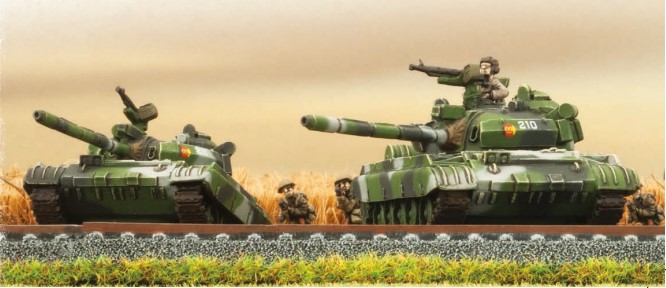
So what is new in Analytics V3?
After the publication of Analytics V2, I received quite a few comments and e-mails asking me if could add the data on the types of Armies that I have played and the Tank Teams and Air Units in my Army Lists. That information has been added in various sections of this article.
So, let’s start with the definition of Analytics.
The Business Dictionary defines Analytics; as the study of past historical data to research potential trends.
Type of Data that has been collected?
When I originally started collecting the data in, In July 2018, I wanted to answer can I monitor the performance of a new Team Yankee Army? I felt that if I was going to make a financial and time investment to purchase and build a new Team Yankee Army. Could I gain an understanding of the types of armies that I would oppose, how often did I Attack vs Defend, and what was the mission? Did they have Air? What kind of Tank team did they have?
To answer those types of questions, I started writing down some simple consistent notes about each of my games. The following is what I have collected for each of my Team Yankee tournament games since July 2018:
- Date and Location of the tournament
- What was the mission?
- Did I attack or defend?
- What was the opponent’s army’s nationality?
- Did the opponents have Armor? If yes what types of tank units did they have?
- Did the opponents have air? If yes what types of air units did they have?
- What was the # of points used?
I also have started adding a brief description of the opponent’s list. EX: US M-113 Mech Company with a Canadian Leo-1 Company allied formation. Also, I do not document quantities, EX: 13 Leo-1 or 9 Leo-1 Tanks are just Leo-1 Tanks encountered.

Chart Notes: on the Charts below V1 & V2 means Team Yankee Version V1 & V2
# of points used for each Tournament
The chart below reflects the points used for each of the 36 tournaments that generated the 114 Team Yankee Games. Currently the 90-99 and Variable have been the most popular point tournaments that I have played.
Note on Variable: Variable means that the TO has set different point values for each of the rounds.
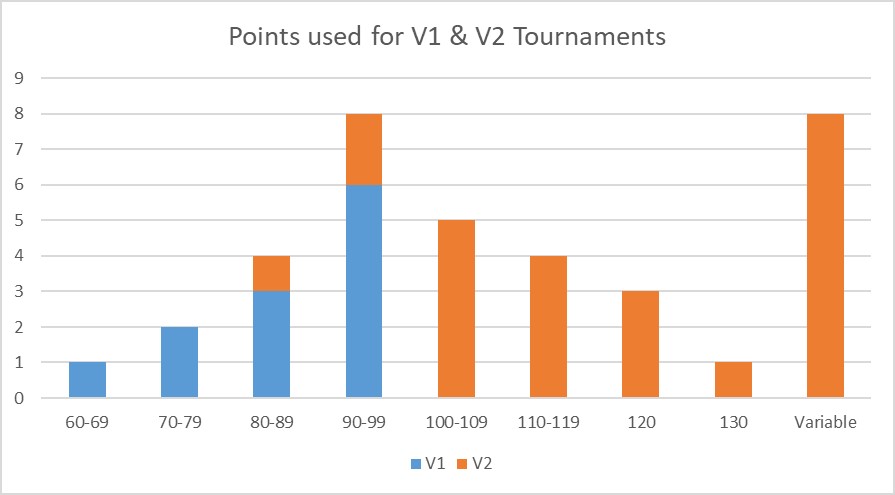
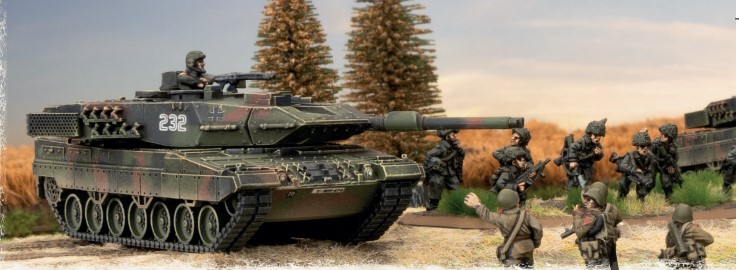
What was the mission?
The Chart Below illustrates the % of the Mission types that have been played over the last 114 Team Yankee games. When you compare the current 114 missions that have been played vs the prior two versions of this article you will notice the downward change in the top 5 missions played as the Extended Battle Plans out of the Team Yankee Missions Pack now account for 14% of the total missions that have been played.
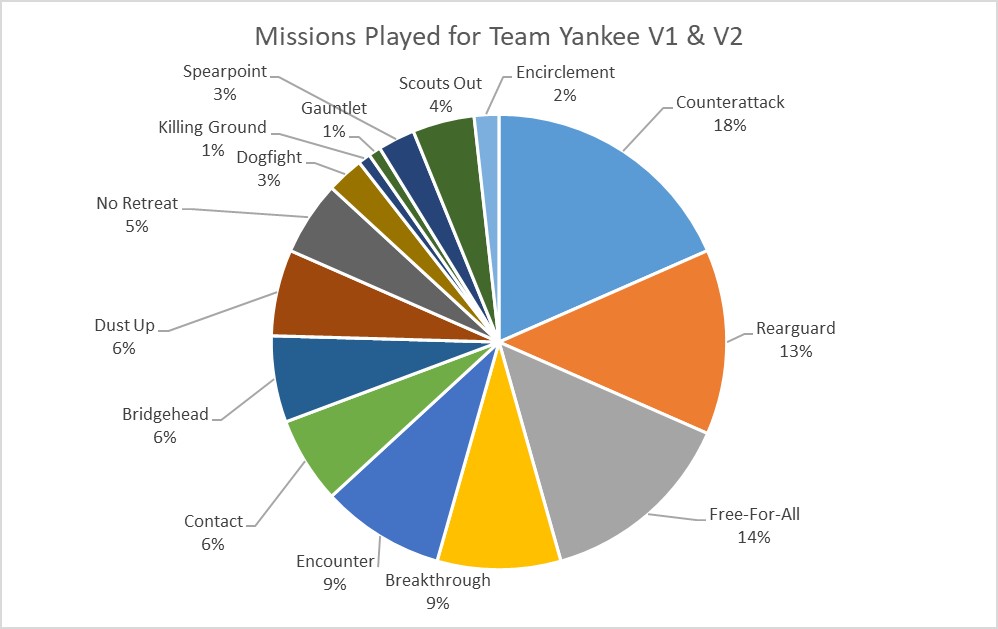
Note: The Team Yankee Missions Pack was used in all of the recent tournaments the Tournament Organizers (TO’s) have been using the Extended Battle Plans Matrix. In some cases, they may limit or mandate the number of Attack, Defend or Maneuver stances for each tournament or may provide the Missions.
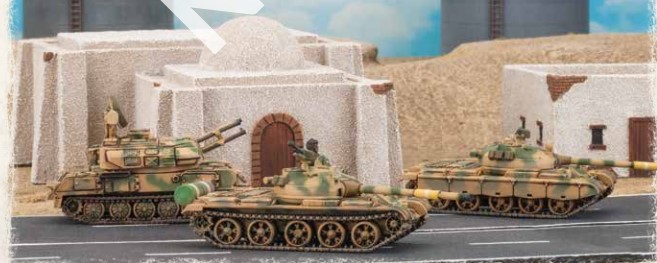
Did I Attack or Defend?
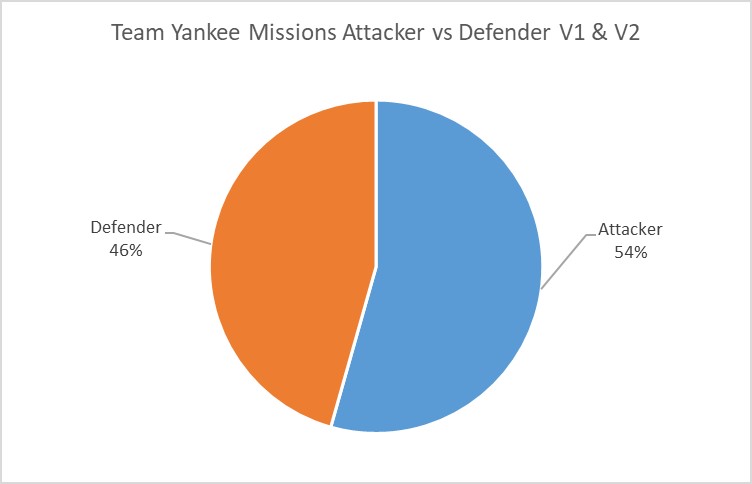
The chart above illustrates the % of the time that I Attacked vs Defended. This chart reflects a 5% increase in the % that I attack vs the V2 article. Since the V2 article, I have been playing lists with 2 tank formations and normally pick an Attack or Maneuver Stance. This reduces my risk of having to play a Deep Reserves Mission. In tournaments where the TO mandates that you use each stance once, I replace my 2nd tank formation with an infantry formation.

Opponent’s Armies Nationality?
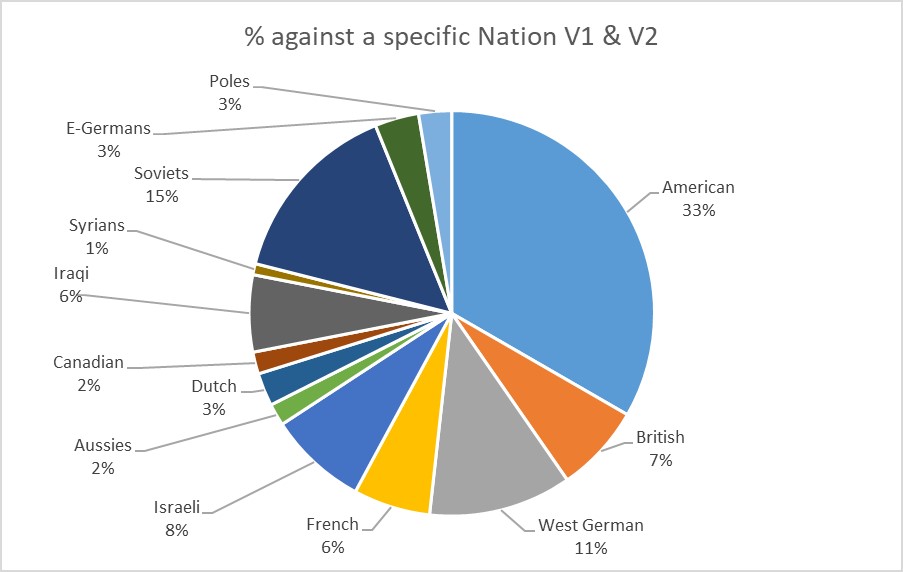
The chart above illustrates the % of times that I faced a specific nation. Based on the location of the tournaments that I have entered, the entry still leans very heavily towards the NATO faction. The 78% vs 22% NATO vs Warsaw Pact is pretty consistent with my first two articles. In my previous article, I counted the Iraqis in with the Warsaw Pact faction and corrected that in this article.
Since the previous article, I have faced multiple different Israeli players, which accounts for the near doubling of the games vs Israelis. Also, I have seen more players using more light formations for their 2nd or allied formations such as American LAV Companies, Light Attack Companies, and Light Cavalry Troops. Also as expected I have seen more West German Marder-2 Formations. This knowledge has defiantly helped me with list construction as my opponents’ army’s meta changes.
In 2022 I think you might see the above mix change especially with the new Warsaw Pact book.
Note on the above chart data: The above data only represents the nationality of the core formation of my opponent’s lists and does not account for an Allied formation that might be in my opponent’s list in a specific game. EX: the United States with a West German Ally.
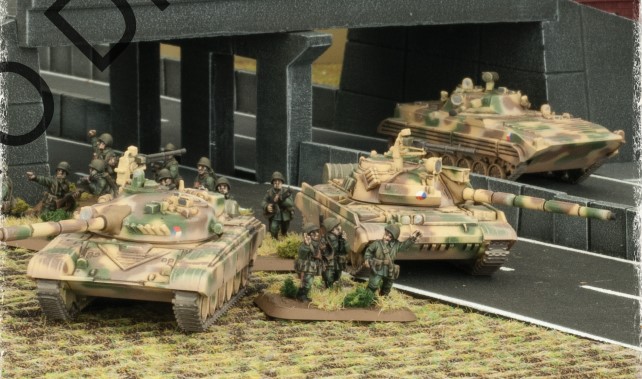
What have I been playing?
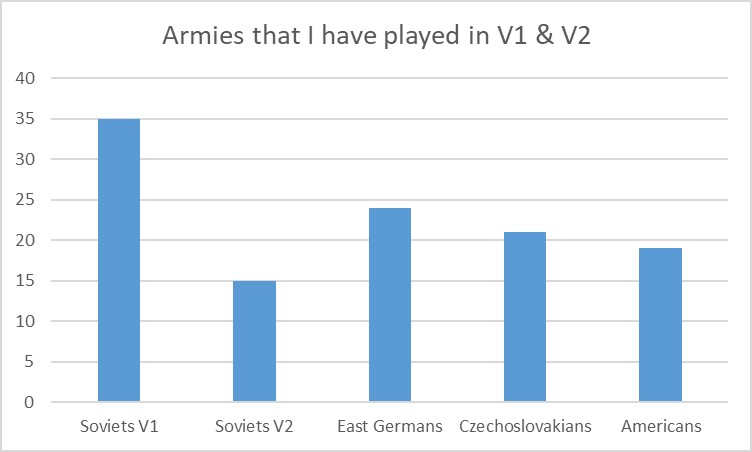
The chart above illustrates the # of times that I played a specific nation in the 114 games played.
The above nations lists that I played had the following additional breakdowns:
- Soviet BMP Infantry, and or T-62M Tank formations and sometimes with Allied East German T-55AM2, T-72M Tank, or Czechoslovakian T-72M formations.
- East German BMP Infantry formations + Soviet Allied T-62M Tank formations.
- Americans Bradley Mech Infantry formation + various American 2nd formations and sometimes West German M-113 Allied Formation
- Czechoslovakian T-72M and T-72B formations and sometimes a Soviet BMP-2/BMP-3 allied formation.

Did the opponent have Air?
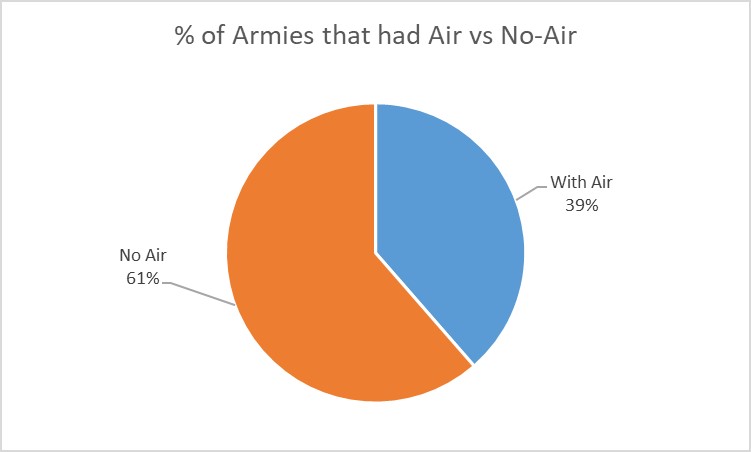
The above chart reflects a 6% decrease in the number of times that I encountered players having Air units in their lists from my V2 Article. This decrease has surprised me. In my V2 article, I stated that I thought I would continue to see an increase in the % of air units that my opponents are using. I still think we should see an increase in Air units being used, with the arrival of the low-cost Su-17 and SU-22 air units in the new Warsaw Pact Book.
But that will be based on the ratio of NATO vs Warsaw Pact changes in my tournament area. Also just because they have them on their lists does not mean they ever leave the comforts of their aircraft shelters. In many of the games, my opponent’s Air Units never arrive or make a single appearance. Going forward my lists will continue to have at least two or three Anti Aircraft Units.
Note: Air is both Airplanes and Attack Helicopters.
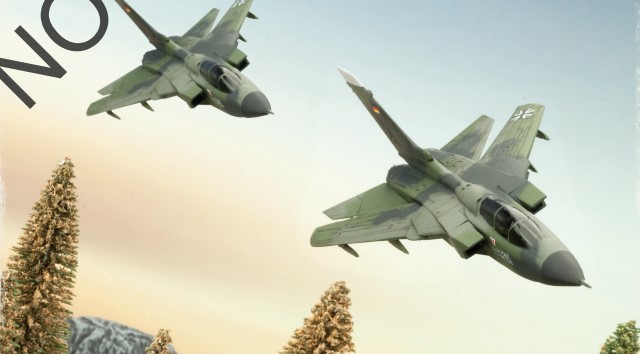
Air Units Encountered
The chart below was constructed in response to several of the comments and suggestions that I received from people reading the first publication of Team Yankee Analytics, asking if I had data on the types of Air Units that I encountered.
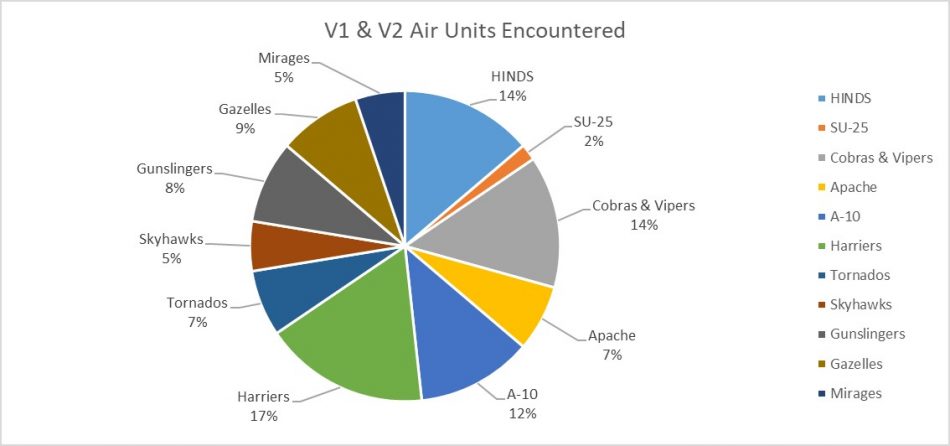
The chart above reflects the 58 different Air Units that I encountered that my opponents had in their lists in the past 114 games. In several cases, players had multiple Air Units in their lists. EX: Mirages and Gazelles.
Note on the above data: If a player had three Hind units in their list the above chart would only reflect one encounter, in tournaments that allowed players to have multiple lists or the points varied per round. I only accounted for Air Units that were on the lists that I played against in that tournament.

Combined V1 and V2 Tank Units Encountered
The chart below was constructed in response to several of the comments and suggestions that I received from people reading the first publication of Team Yankee Analytics, asking if I had the data on the types of Tank Units that I encountered in my 114 games.
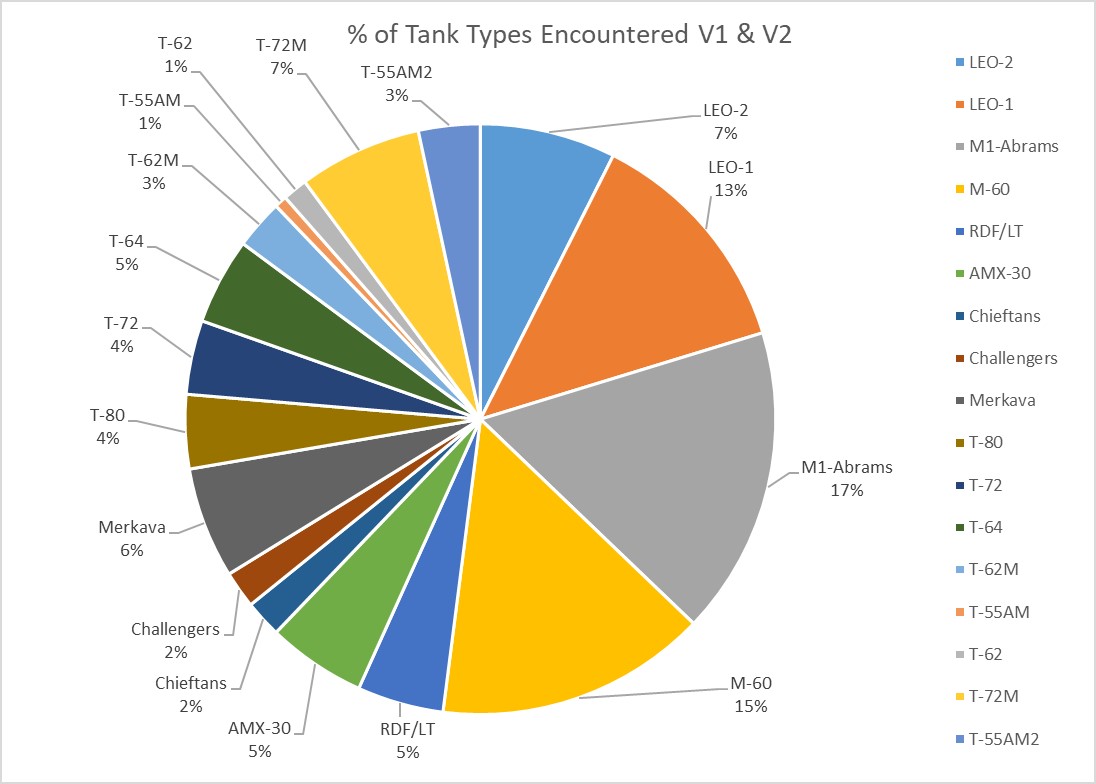
The chart above shows the types of tank units that I have encountered in the last 114 games. I can use the data from this chart and compare it to the Nations that I have played against and it should help in future list construction or list tweaking. EX: Since I have encountered the US lists 33% of the time, I should have lists that can deal with the M1-Abrams that I have encountered 17% of the time.
Logically if I can deal with an M1-Abrams I should be able to deal with the US or Israeli M-60s, you might see more M-60s than you would see M1 Abrams and you might adjust if folks play M-60s in your playing area. I will be adding T-72B and T-55 Missile Tanks once I encounter them.
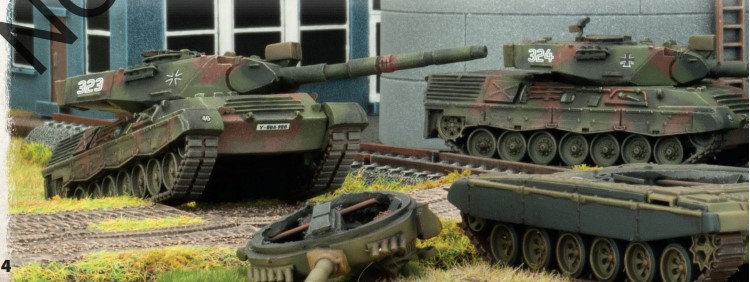
List Construction Possible Changes
With the arrival of the new Warsaw Pact Book for Team Yankee, one of the major new units is the T-72B which is available for the Poles, East Germans, Czechoslovakians, and Soviets. If I look at the above data, I have faced tank units with AT < = 20 66% of the time and AT > 20 34% of the time. With that info and compare that to the number of times that I have played East Germans and Czechoslovakians in 40% of my games.
Replacing at least some of my T-72Ms and with T-72Bs with FA18 should help reduce the number of tank losses that I have taken when playing against armies whose tanks are AT <=20 and now have a dice roll chance vs AT>20. Also upgrading a T-55AM2 unit to a T-55AM2 Missile Tank is another option.
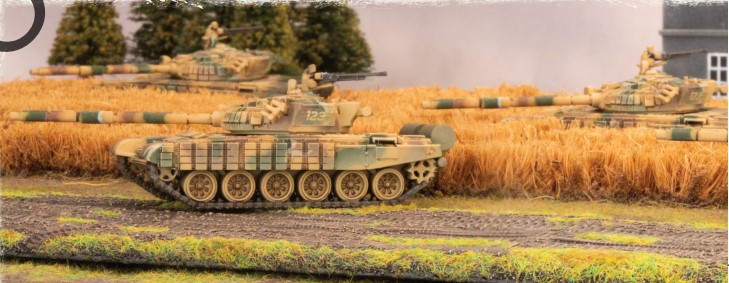
Comments on the Tank and Air Chart Data
Just to clarify what you are seeing in the charts, it shows the % of times that one of my opponents had a specific tank unit in their army list. So when you see that I played against M-60 tanks 15% of the time, it does not state how many M-60s. It could be between one platoon to several platoons on an opponent’s list. In a specific tournament if I encountered 3 different players playing M-60s then that would be counted as three for my data set.
This is the same way that I collected the Air Unit data. I also do not differentiate between a Dutch, West German, Canadian, or Aussie Leo-1, they are just Leo-1s for my data collection purposes. The same with M1-Abrams, I did not break down the different M1-Abrams tanks. They are all just Abrams tanks. I hardly ever see an up-gunned Abrams Tank unit. I did this to simplify the charts and my data collection. But I do collect it for the different Warsaw Pact type tanks such as the T-72, T-72M, T-62M, T-62, T-55AM, and the T-55AM2 since the vehicles have different stats.
In tournaments that players could or had to use multiple lists where each round of the tournament you could have different point levels or could choose between two different lists to use. My data only reflects the lists that I played against, not what the player could use in a different round.
Also, none of the Tank types in my armies are in the charts above. The chart below shows the tank types that I used in the 114 games.
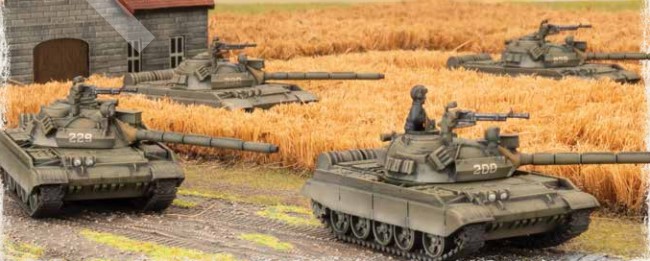
My Tank Data
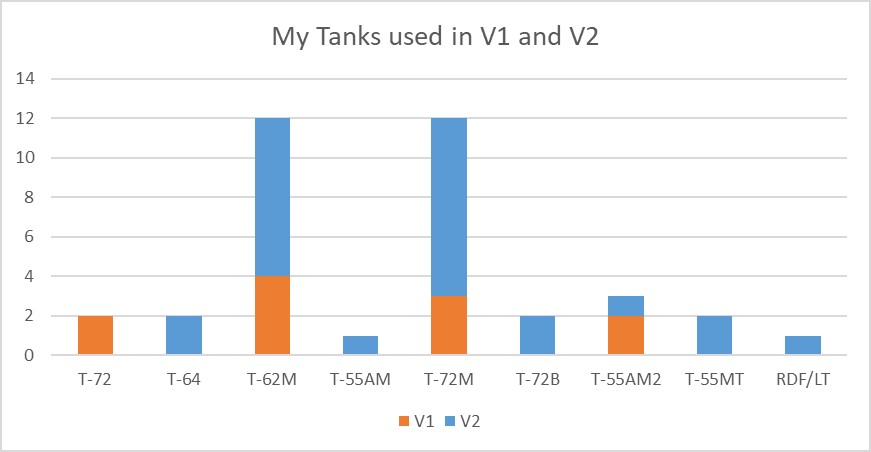
The chart above reflects the tank units that I used in a specific tournament, not the number of times they appeared in each of the tournaments. Not all of my various army lists that I used had tank units in them. When I bring out the V4 article the T-72B and T-55MT will play key roles in my go-forward East German and Czechoslovakian army lists.
Summary:
Collecting the data and storing it in something like Excel was pretty easy, you do not need to be an Excel guru to build the charts and graphs that I have enclosed. The collected data and the results from the analysis of that data have helped me construct better lists. This same approach could be used for Flames of War.
One thing to remember is that your results will vary based on what your opponents are playing in tournaments that you play in.
Send me your questions or ideas on what you might want to see added, I normally reply in a few days.
Good luck with your Team Yankee Analytics, see you in about 25 to 35+ games for V4.
 By Jim Naughton
By Jim Naughton
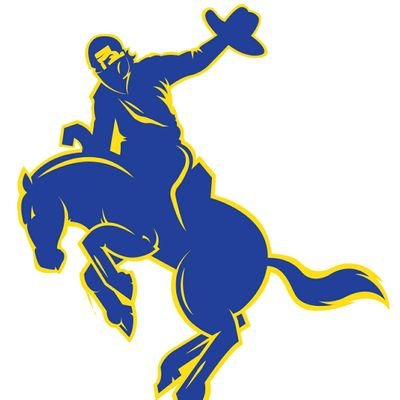
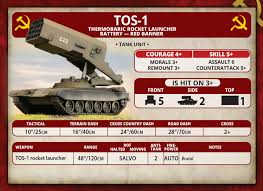 By Jim Naughton
By Jim Naughton




















